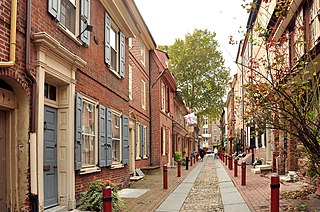The National Register of Historic Places (NRHP) is the United States federal government's official list of districts, sites, buildings, structures, and objects deemed worthy of preservation for their historical significance or "great artistic value". A property listed in the National Register or located within a National Register Historic District, may qualify for tax incentives derived from the total value of expenses incurred in preserving the property.

The National Trust for Historic Preservation is a privately funded, nonprofit organization based in Washington, D.C., that works in the field of historic preservation in the United States. The member-supported organization was founded in 1949 by congressional charter to support the preservation of America’s diverse historic buildings, neighborhoods, and heritage through its programs, resources, and advocacy.
In the broadest sense, cultural resource management (CRM) is the vocation and practice of managing heritage assets, and other cultural resources such as contemporary art. It incorporates Cultural Heritage Management which is concerned with traditional and historic culture. It also delves into the material culture of archaeology. Cultural resource management encompasses current culture, including progressive and innovative culture, such as urban culture, rather than simply preserving and presenting traditional forms of culture.

Historic preservation (US), built heritage preservation or built heritage conservation (UK) is an endeavor that seeks to preserve, conserve and protect buildings, objects, landscapes or other artifacts of historical significance. It is a philosophical concept that became popular in the twentieth century, which maintains that cities as products of centuries' development should be obligated to protect their patrimonial legacy. The term refers specifically to the preservation of the built environment, and not to preservation of, for example, primeval forests or wilderness.

The National Historic Preservation Act is legislation intended to preserve historic and archaeological sites in the United States of America. The act created the National Register of Historic Places, the list of National Historic Landmarks, and the State Historic Preservation Offices.
The State Historic Preservation Office (SHPO) is a state governmental function created by the United States federal government in 1966 under Section 101 of the National Historic Preservation Act (NHPA). The purposes of a SHPO include surveying and recognizing historic properties, reviewing nominations for properties to be included in the National Register of Historic Places, reviewing undertakings for the impact on the properties as well as supporting federal organizations, state and local governments, and private sector. States are responsible for setting up their own SHPO; therefore, each SHPO varies slightly on rules and regulations. To link these differences with the SHPOs, the National Conference of State Historic Preservation Officers (NCSHPO) was created as a "point of contact" according to the National Historic Preservation Act.

The National Wilderness Preservation System (NWPS) of the United States protects federally managed wilderness areas designated for preservation in their natural condition. Activity on formally designated wilderness areas is coordinated by the National Wilderness Preservation System. Wilderness areas are managed by four federal land management agencies: the National Park Service, the U.S. Forest Service, the U.S. Fish and Wildlife Service, and the Bureau of Land Management.

Historic districts in the United States are designated historic districts recognizing a group of buildings, archaeological resources, or other properties as historically or architecturally significant. Buildings, structures, objects, and sites within a historic district are normally divided into two categories, contributing and non-contributing. Districts vary greatly in size and composition: a historic district could comprise an entire neighborhood with hundreds of buildings, or a smaller area with just one or a few resources.

In the law regulating historic districts in the United States, a contributing property or contributing resource is any building, object, or structure which adds to the historical integrity or architectural qualities that make the historic district significant. Government agencies, at the state, national, and local level in the United States, have differing definitions of what constitutes a contributing property but there are common characteristics. Local laws often regulate the changes that can be made to contributing structures within designated historic districts. The first local ordinances dealing with the alteration of buildings within historic districts was enacted in Charleston, South Carolina in 1931.
The history of the National Register of Historic Places began in 1966 when the United States government passed the National Historic Preservation Act (NHPA), which created the National Register of Historic Places (NRHP). Upon its inception, the U.S. National Park Service (NPS) became the lead agency for the Register. The Register has continued to grow through two reorganizations, one in the 1970s and one in 1980s and in 1978 the NRHP was completely transferred away from the National Park Service, it was again transmitted to the NPS in 1981.

The U.S. National Register of Historic Places (NRHP) classifies its listings by various types of properties. Listed properties generally fall into one of five categories, though there are special considerations for other types of properties which do not fit into these five broad categories or fit into more specialized subcategories. The five general categories for NRHP properties are: building, district, object, site, and structure.
The Historic Preservation Fund (HPF) provides financial support for historic preservation projects throughout the United States. The fund is administered by the National Park Service (NPS), pursuant to the National Historic Preservation Act of 1966 (NHPA). The fund provides state historic preservation agencies with matching funds to implement the act.

The Alabama Historical Commission is the historic preservation agency for the U.S. state of Alabama. The agency was created by an act of the state legislature in 1966 with a mission of safeguarding Alabama's historic buildings and sites. It consists of twenty members appointed by the state governor or who serve in an official position. The members represent a broad cross section of Alabamians including architects, historians, archaeologists, and representatives of state universities. The commission is tasked with acquisition and preservation of historic properties and education of the public about historic sites in Alabama.
The Department of Archaeology and Historic Preservation (DAHP) is an independent government agency in Washington state which serves several functions, including regulatory functions. The agency inventories and regulates archaeological sites; houses Washington's State Historic Preservation Officer, State Archaeologist, State Architectural Historian and State Physical Anthropologist; maintains the Washington Heritage Register and Heritage Barn Register; provides expertise on environmental impacts to cultural resources; administers historic preservation grants for heritage barns and historic county courthouses; encourages historic preservation through local governments; provides technical assistance for historic rehabilitation and using historic preservation tax credits; and maintains extensive GIS databases to catalog the state's historic and prehistoric cultural resources.

Lincoln Place Apartment Homes is a historic apartment community owned by a subsidiary of Apartment Investment and Management Co. (Aimco). Inspired by the garden city movement, it is located at 1050 Frederick Street on a 35-acre site in the Venice community of Los Angeles, one mile east of Venice Beach. Built from 1949-1951, the property is just off Lincoln Boulevard, bound by Lake Street and Penmar Avenue with Elkgrove Avenue and Elkgrove Circle within its interior.

The New Hampshire State Register of Historic Places (NHSRHP) is a register of historic places administered by the state of New Hampshire and the New Hampshire Division of Historical Resources. Buildings, districts, sites, landscapes (such as cemeteries, parks or town forests), structures, or objects can be added to the register. The register was initiated in 2001 and is authorized by RSA 227 C:33.
Wintersburg Village is an area in Huntington Beach, California, United States, that represents over a century of Japanese immigration to the United States. The property, consisting of six structures on a 4.5-acre (1.8 ha) parcel, was noted as eligible for the National Register of Historic Places in the City of Huntington Beach General Plan in 2014. The C.M. Furuta Gold Fish Farm and the Wintersburg Japanese Mission are recognized nationally by historians as a rare, pre-1913 Japanese pioneer-owned property with intact physical features that convey the progression of Japanese American history.
The Columbus Register of Historic Properties is a register for historic buildings and other sites in Columbus, Ohio, United States. The register is maintained by the City of Columbus Historic Resources Commission and Historic Preservation Office, and was established in 1980. Many of these landmarks are also listed on the National Register of Historic Places, providing federal tax support for preservation, and some are further designated National Historic Landmarks, providing additional federal oversight.









